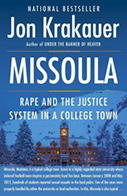Missoula: Rape and the Justice System in a College Town

Author: Jon Krakauer
Publisher: New York: Doubleday (Anchor Books), 2015. 416p.
Reviewer: Allison Crowe | May 2016
In recent years, colleges and universities across the U.S. have been forced, due to public scandals and government investigations, to confront the pervasive problem of sexual assault on their campuses. In Missoula, Jon Krakauer adds the University of Montana to this list, with an in-depth, meticulously reported account of sexual assaults on UM’s campus, and the subsequent failure of the criminal justice system to adequately address the problem. As Krakauer points out, what is most striking about Missoula’s story isn’t how unusual it is, but how commonplace it is. And, while each female victim suffers her own personal hell, the institutional response from police, prosecutors, the university, and the community ranged from utter indifference to outright hostility.
Through first-hand interviews, Krakrauer describes, in horrifying detail, how four young women were sexually assaulted by University of Montana students on campus. Allison Huguet went to a party at the house of Beau Donaldson, a childhood friend who played for the UM football team. Not wanting to drive home, and trusting Beau, who felt like “a brother” to her, she fell asleep on his couch, only to wake up to him pulling off her pants and raping her (11-17). Kelsey Belnap was gang-raped by four UM football players in her friend’s apartment after the players encouraged her to take shots (39-41). And, finally, Kaitlyn Kelly and Kerry Barrett were assaulted in the same week, by young men they met at Missoula bars (57-76).
For these young women, the horror only began with the assault. It worsened once they decided to report to the police. Studies have shown that rape is seriously underreported, especially on college campuses, and Krakauer illustrates why. In case after case, Krakauer carefully recounts how police relied on stereotypes and myths about rape, rather than taking rape complaints seriously and conducting thorough investigations (42-49; 59-68; 76-87).
Yet, Krakauer rightfully saves his most damning indictment for the Missoula County District Attorney’s Office, which (according to a Department of Justice investigation), “neither encouraged prosecutors to aggressively pursue challenging cases nor provided them with the specialized training necessary to do so effectively” (368). Of 350 sexual assaults reported to the Missoula Police Department between January 2008 and May 2012, the Missoula County Attorney’s Office declined to prosecute nearly every case of non-stranger assault involving an adult victim who was, at the time of the assault, subject to some type of heightened vulnerability – for example, in cases facilitated by drugs or alcohol – even when the assailant had confessed or made incriminating statements (354-57).
It is this failure of the adversarial system that makes this a valuable read for all future and current lawyers. Ultimately, what readers will mostly take away from Krakauer’s book are the voices of the victims, now survivors. That he gave these resilient women a platform to tell their stories is perhaps the most important takeaway from Missoula.
Allison Crowe, Villanova University School of Law (JD, 2016)


